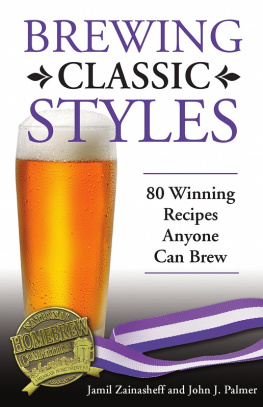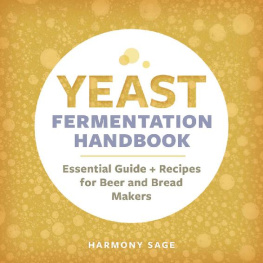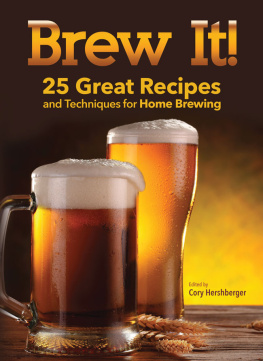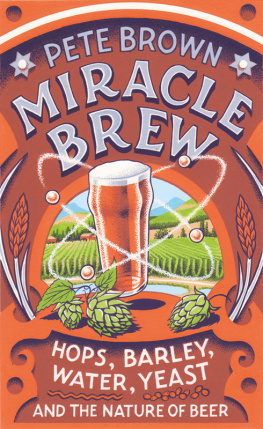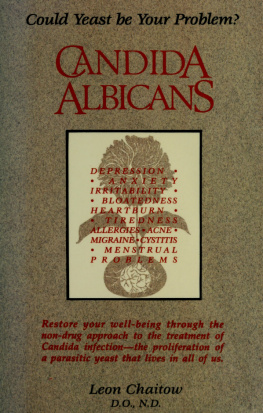Yeast
The Practical Guide to Beer Fermentation
Chris White with Jamil Zainasheff

Brewers Publications
A Division of the Brewers Association
PO Box 1679, Boulder, Colorado 80306-1679
BrewersAssociation.org
Copyright 2010 by Brewers Association
All rights reserved. No portion of this book may be reproduced in any form without written permission of the publisher. Neither the authors, editor nor the publisher assume any responsibility for the use or misuse of information contained in this book.
Printed in the United States of America.
10 9 8 7 6 5 4 3
ISBN: 0-937-381-96-9
ISBN-13: 978-0-937381-96-0
Library of Congress Cataloging-in-Publication Data
White, Chris, 1968
Yeast: the practical guide to beer fermentation / by Chris White with Jamil Zainasheff.
p. cm.
Includes bibliographical references and index.
ISBN-13: 978-0-937381-96-0
ISBN-10: 0-937381-96-9
1. Brewing. 2. Yeast. 3. Fermentation. I. Zainasheff, Jamil, 1961
II. Title.
TP580.W45 2010
641.873--dc22
2010029741
Publisher: Kristi Switzer
Technical Editor: William L. Pengelly, Ph.D.
Copy Editing and Index: Daria Labinsky
Production & Design Management: Stephanie Johnson
Cover and Interior Design: Julie Korowotny
Cover Illustration: Alicia Buelow
Interior Images: White Labs unless otherwise noted
table of contents
Acknowledgements
This is a book I wanted to write for a long time. Ive written about yeast, spoken about yeast, and worked with yeast every day for what seems like forever. I wanted to put that information and more into one source. I began to write the book three years ago with my brother, Mike White. We put a lot of material together, but it was still missing something. When Jamil Zainasheff came into the project, the book really began to take shape. Jamil added a lot of information and a professional touch. He is not only a great writer and brewer but also a good friend. The Brewers Association was a natural place for me to publish the book; Ray Daniels was very helpful in the beginning, then Kristi Switzer took over and has done a great job. I want to thank the people who contributed or reviewed material: Neva Parker, Lisa White, Troels Prahl, Mike White, Sharon Fernandez, Liz Strohecker, Lee Chase, Yuseff Cherney, Dan Drown, and Craig Duckham.
I also want to thank the many people who have supported the book, given me information, or helped in other ways: Jamie Reyes, John Schulz, Tomme Arthur, Jack White, Justin Crossly, Saskia Schmidt, John White, Tobias Fischborn, Graeme Walker, Sharon Heredia, Jay Prahl, Meg Falbo, Pam Marshall, Michael Lewis, Randy Mosher, Betsy Komives, Barbara Maisonet, Joanne CarilliStevensen, Lyn Kruger, the Maynard A. Amerine Viticulture & Enology Room at the University of California at Davis Shields Library, where I did most of my writing, Chris Boulton and David Quain for their great yeast book Brewing Yeast & Fermentation and personal discussions, Brew Your Own magazine, Zymurgy magazine, and New Brewer for some of the articles I have written, twenty-twos at Sudwerk Brewery, the many homebrewers and commercial brewers who have taught me so much, and of course my supporting and loving parents, Eric and Gina White.
Chris White
I could not have completed this book without the love, assistance, and support of my family: I do love them more than beer or brewing, but they never ask me to prove it. They know how hard I work on these books and how it takes away from family time as the deadline nears. For this book, they even put up with Dad furiously editing and writing during the family vacation to Disneyland. While my children, Anisa and Karina, are very supportive, my wife, Liz, goes much further and even helps edit all of my writing. I know my wife does not believe me when I tell her, Dear, all homebrewers have their own yeast lab, but I really appreciate that she lets me spend money on and take up space with a lab, anyway. Yes, I know, I lead a charmed life.
Besides my family, this book would not exist without the help of many dear friends. I would especially like to thank Peter Symons for his dedication to reviewing every last word with a critical eye and letting me know where I went astray or had outdated information. I cannot express how strong the support and feedback of John Palmer, John Tull, Gordon Strong, and Gary Angelo has been, not only to this book, but to all of my writing and beer thinking.
Thank you also to those who believed I had the knowledge and ability to get this book done, especially Ray Daniels, Kristi Switzer, Chris White, and Justin Crossley.
A special thank you to Samuel Scott. Even though he was in the middle of moving, he found the time to create some great photos for the book. Then I asked for more, and he sent those, too.
As usual, there are so many others who helped with information, photos, or support. I avoid listing them, not because their contributions were less significant, but rather my memory is shoddy and I know I would accidentally leave someone off the list.
And thank you my friends, my brewing brothers and sisters, you have shared your beers, your homes, your knowledge, and most important to me, your friendship. I am forever grateful.
Jamil Zainasheff
Portions of the text were previously published in Zymurgy and Brew Your Own magazines.
You can find the latest version of the Beer Judge Certification Program Style Guidelines at the BJCP website, www.bjcp.org.
Foreword
We brewers dont make beer, we just get all the ingredients together and the beer makes itself.
Fritz Maytag
Beer does not make itself properly by itself. It takes an element of mystery and of things that no one can understand.
Fritz Maytag
Ive always liked these two quotes, as I believe they perfectly illustrate the mysteries of fermentation, the least understood and often the most neglected part of the brewing process. If you read beer recipes provided on various brewing websites and in brewing books, youll see that much attention is paid to things like grain bills, and more significantly these days, to hop bills. Yeast seems a bit like an afterthought, and maybe thats because it has been that way throughout much of history.
Read historical brewing books and you will find plenty of references to malting, malt quality, hop growing, hop quality, and even water quality. These processes were well understood fairly early in the game. But because most brewers believed fermentation was a spontaneous process, there are virtually no references to yeast in historical texts. This despite the fact the brewers realized how critical yeast is to the brewing process, calling yeast godisgood, berme, and yeste. Yeast is often only mentioned in passing in recipes and procedural texts. Even the first version of the German purity law, Reinheitsgebot, failed to include yeast as an ingredient in beer. And on the occasions that yeast is explored thoroughly in historical texts, its a tough read, because the information is painfully inaccurate.
What is even more amazing is that despite this lack of knowledge, understanding, or willingness to address the inclusion of yeast as a vital ingredient, brewers knew yeast was important, and they knew fairly early on that they had to harvest yeast and repitch it to the next fermentor to ensure the successful transformation of wort to beer. Yeast strains have survived for hundreds, if not thousands, of years, and have been successfully maintained and carefully selected to become the multitude of wonderful strains that are available to brewers everywhere today. Throughout history brewing processes evolved that favored the maintenance of yeast strains. Techniques such as top cropping, repitching, lagering, and seasonal brewing to maintain good fermentation temperature were all developed to ensure complete fermentations and delicious beer, despite brewers having no real understanding of what yeast was and how it worked. Even as recently as the late 1800s, after Louis Pasteur proved that fermentation is a result of metabolism by yeast, a living organism, brewing literature was chock-full of marketing speak references to yeast: yeast must be of the


